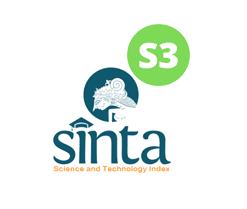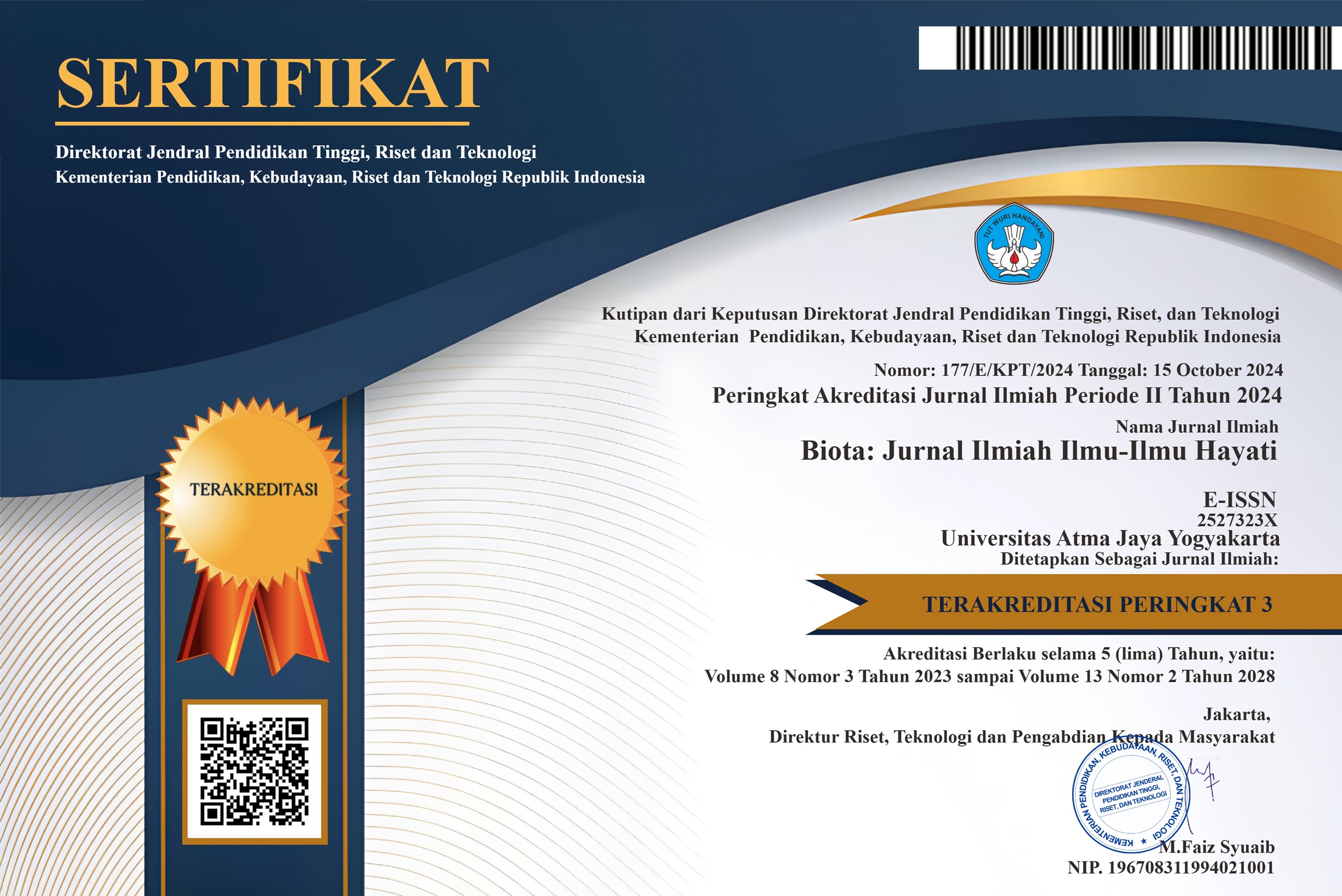Predatory Activity of Myxobacteria Corallococcus exiguus against Soil Inhabiting Bacteria
DOI:
https://doi.org/10.24002/biota.v8i1.5710Keywords:
antibacterial, Corallococcus, Myxobacteria, predator, prey, soilAbstract
Prokaryotic micropredators, including myxobacteria, shape the structure of the community in the soil as they prey on other microorganisms. Their unique behavior in nature has raised the interest in exploiting these bacterial groups to combat the threatening antibiotic resistance. The objective of this study is to assay the antibacterial activity of Corallococcus exiguus, a member of myxobacteria, based on their predation ability against soil inhabiting bacteria. A total of 17 soil bacteria from different taxa were preyed upon three C. exiguus isolates on TPM buffer agar medium. Based on the predation assay, all the three isolates actively killed all the Gram-negative Alphaproteobacteria and Betaproteobacteria members used in this study. Protease producing assay using casein as substrate revealed that these isolates were able to break down the protein with lytic index up to 1.33 ± 0.10. Their ethyl acetate extracts slightly inhibited the growth of one selected Gram-positive bacterium. Hydrolytic enzyme and secondary metabolite produced by C. exiguus are considered to play an important role in their predation activity.
References
Akbar, S. and Stevens, D. C. (2021). Functional genomics study of Pseudomonas putida to determine traits associated with avoidance of a myxobacterial predator. Scientific Reports 11(1): 1-15.
Balouiri, M., Sadiki, M. and Ibnsouda, S. K. (2016). Methods for in vitro evaluating antimicrobial activity: A review. Journal of Pharmaceutical Analysis 6(2): 71-79.
Berleman, J. E., Allen, S., Danielewicz, M. A., Remis, J. P., Gorur, A., Cunha, J., Hadi, M.Z., Zusman, D.R., Northen, T.R., Witkowska, H.E. and Auer, M. (2014). The lethal cargo of Myxococcus xanthus outer membrane vesicles. Frontiers in Microbiology 5: 474.
Berleman, J. E., Chumley, T., Cheung, P. and Kirby, J. R. (2006). Rippling is a predatory behavior in Myxococcus xanthus. Journal of Bacteriology 188(16): 5888-5895.
Berleman, J. E. and Kirby, J. R. (2009). Deciphering the hunting strategy of a bacterial wolfpack. FEMS Microbiology Reviews 33(5): 942-957.
Dahm, H., Brzezińska, A. J., Wrótniak-Drzewiecka, W., Golińska, P., Różycki, H. and Rai, M. (2015). Myxobacteria as a potential biocontrol agent effective against pathogenic fungi of economically important forest trees. Dendrobiology 457(2020): 1-8
Dong, H., Xu, X., Gao, R., Li, Y., Li, A., Yao, Q. and Zhu, H. (2022). Myxococcus xanthus R31 suppresses tomato bacterial wilt by inhibiting the pathogen Ralstonia solanacearum with secreted proteins. Frontiers in Microbiology 12: 1–12.
Feng, S., Tan, C. H., Constancias, F., Kohli, G. S., Cohen, Y. and Rice, S. A. (2017). Predation by Bdellovibrio bacteriovorus significantly reduces viability and alters the microbial community composition of activated sludge flocs and granules. FEMS Microbiology Ecology 93(4): fix020.
Grenier, D. (1994). Effect of proteolytic enzymes on the lysis and growth of oral bacteria. Oral Microbiology and Immunology 9(4): 224-228.
Gu, Z., Eils, R. and Schlesner, M. (2016). Complex heatmaps reveal patterns and correlations in multidimensional genomic data. Bioinformatics 32(18): 2847-2849.
Iebba, V., Totino, V., Santangelo, F., Gagliardi, A., Ciotoli, L., Virga, A., Ambrosi, C., Pompili, M., De Biase, R. V., Selan, L., Artini, M., Pantanella, F., Mura, F., Passariello, C., Nicoletti, M., Nencioni, L., Trancassini, M., Quattrucci, S. and Schippa, S. (2014). Bdellovibrio bacteriovorus directly attacks Pseudomonas aeruginosa and Staphylococcus aureus cystic fibrosis isolates. Frontiers in Microbiology 5: 280.
Im, H., Dwidar, M. and Mitchell, R. J. (2018). Bdellovibrio bacteriovorus HD100, a predator of Gram-negative bacteria, benefits energetically from Staphylococcus aureus biofilms without predation. ISME Journal 12(8): 2090-2095.
Kaitala, V., Hiltunen, T., Becks, L. and Scheuerl, T. (2020). Co-evolution as an important component explaining microbial predator-prey interaction. Journal of Theoretical Biology 486: 11009.
Kim, Y. J., Kim, H. J., Kim, G. W., Cho, K., Takahashi, S., Koshino, H. and Kim, W. G. (2016). Isolation of Coralmycins A and B, Potent Anti-Gram Negative Compounds from the Myxobacteria Corallococcus coralloides M23. Journal of Natural Products 79(9): 2223-2228.
Kiran, T., Asad, W., Siddiqui, S., Ajaz, M. and Rasool, S. A. (2015). Industrially important hydrolytic enzyme diversity explored in stove ash bacterial isolates. Pakistan Journal of Pharmaceutical Sciences 28(6): 2035-2040.
Kongrueng, J., Mitraparp-Arthorn, P., Bangpanwimon, K., Robins, W., Vuddhakul, V. and Mekalanos, J. (2017). Isolation of Bdellovibrio and like organisms and potential to reduce acute hepatopancreatic necrosis disease caused by Vibrio parahaemolyticus. Diseases of Aquatic Organisms 124(3): 223-232.
Lee, C. S., Jung, Y. T., Park, S., Oh, T. K. and Yoon, J. H. (2010). Lysinibacillus xylanilyticus sp. nov., a xylan-degrading bacterium isolated from forest humus. International Journal of Systematic and Evolutionary Microbiology 60(2): 281-286.
Li, Y., Zhuo, L., Li, X., Zhu, Y., Wu, S., Shen, T., Hu, W., Li, Y.Z. and Wu, C. (2021). Myxadazoles, myxobacterium-derived isoxazole–benzimidazole hybrids with cardiovascular activities. Angewandte Chemie - International Edition 60(40): 21679-21684.
Livingstone, P. G., Ingleby, O., Girdwood, S., Cookson, A. R., Morphew, R. M. and Whitworth, D. E. (2020). Predatory organisms with untapped biosynthetic potential: Descriptions of novel Corallococcus species C. aberystwythensis sp. nov., C. carmarthensis sp. nov., C. exercitus sp. nov., C. interemptor sp. nov., C. llansteffanensis sp. nov., C. praedator sp. nov. Applied and Environmental Microbiology 86(2): e01931-19.
Meliah, S., Kusumawati, D. I. and Ilyas, M. (2020). Preliminary study of myxobacteria as biocontrol agents for panama disease pathogen, tropical race 4 Fusarium odoratissimum. IOP Conference Series: Earth and Environmental Science 457(1): 012060.
Meliah, S., Kusmiati, M., Hasanah, U. U. and Sulistiyani, T. R. (2022). Screening of indigenous myxobacteria from soil and decaying wood in Toba-Samosir, North Sumatera as antimicrobial producer. Berita Biologi 21(1): 91–99.
Morgan, A. D., MacLean, R. C., Hillesland, K. L. and Velicer, G. J. (2010). Comparative analysis of Myxococcus predation on soil bacteria. Applied and Environmental Microbiology 76(20): 6920-6927.
Müller, S., Strack, S. N., Hoefler, B. C., Straight, P. D., Kearns, D. B. and Kirby, J. R. (2014). Bacillaene and sporulation protect Bacillus subtilis from predation by Myxococcus xanthus. Applied and Environmental Microbiology 80(18): 5603-5610.
Nan, B., Chen, J., Neu, J. C., Berry, R. M., Oster, G. and Zusman, D. R. (2011). Myxobacteria gliding motility requires cytoskeleton rotation powered by proton motive force. Proceedings of the National Academy of Sciences of the United States of America 108(6): 2498-2503.
Pham, V. D., Shebelut, C. W., Diodati, M. E., Bull, C. T. and Singer, M. (2005). Mutations affecting predation ability of the soil bacterium Myxococcus xanthus. Microbiology 151(6): 1865-1874.
RStudio, T. (2020). RStudio: Integrated Development for R. RStudio, Inc., Boston, MA. http://www.rstudio.com.
Schäberle, T. F., Schmitz, A., Zocher, G., Schiefer, A., Kehraus, S., Neu, E., Roth, M., Vassylyev, D. G., Stehle, T., Bierbaum, G., Hoerauf, A., Pfarr, K. and König, G. M. (2015). Insights into structure-activity relationships of bacterial RNA polymerase inhibiting corallopyronin derivatives. Journal of Natural Products 78(10): 2505-2509.
Schmitz, A., Kehraus, S., Schäberle, T. F., Neu, E., Almeida, C., Roth, M. dan König, G. M. (2014). Corallorazines from the myxobacterium Corallococcus coralloides. Journal of Natural Products 77(1): 159-163
Waite, D. W., Chuvochina, M., Pelikan, C., Parks, D. H., Yilmaz, P., Wagner, M., Loy, A., Nagamuna, T., Nakai, R., Whitman, W.B., Hahn, M.W., Kuever, J. and Hugenholtz, P. (2020). Proposal to reclassify the proteobacterial classes Deltaproteobacteria and Oligoflexia, and the phylum Thermodesulfobacteria into four phyla reflecting major functional capabilities. International Journal of Systematic and Evolutionary Microbiology 70(11): 5972-6016.
Wang, C., Liu, X., Zhang, P., Wang, Y., Li, Z., Li, X., Wang, R., Shang, Z., Yan, J., He, H., Wang, J., Hu, W. and Li, Y. (2019). Bacillus licheniformis escapes from Myxococcus xanthus predation by deactivating myxovirescin A through enzymatic glucosylation. Environmental Microbiology 21(12): 4755-4772.
Wang, D. G., Niu, L., Lin, Z. M., Wang, J. J., Gao, D. F., Sui, H. Y., Li, Y. Z. and Wu, C. (2021). The discovery and biosynthesis of nicotinic myxochelins from an Archangium sp. SDU34. Journal of Natural Products 84(10): 2744-2748
Xiao, Y., Wei, X., Ebright, R. and Wall, D. (2011). Antibiotic production by myxobacteria plays a role in predation. Journal of Bacteriology 193(18): 4626-4633
Ye, X., Chen, Y., Ma, S., Yuan, T., Wu, Y., Li, Y., Zhao, Y., Chen, S., Zhang, Y., Li, L., Li, Z., Huang, Y., Cao, H. and Cui, Z. (2020). Biocidal effects of volatile organic compounds produced by the myxobacterium Corrallococcus sp. EGB against fungal phytopathogens. Food microbiology 91: 103502.
Zhao, Y., Wang, Y., Xia, C., Li, X., Ye, X., Fan, Q., Huang, Y., Li, Z., Zhu, C. dan Cui, Z. (2021). Whole-genome sequencing of Corallococcus sp. strain egb reveals the genetic determinants linking taxonomy and predatory behavior. Genes 12(9): 1421.
Downloads
Published
How to Cite
Issue
Section
License
Copyright (c) 2023 Siti Meliah, Miranti Nurindahsari, Ismu Purnaningsih

This work is licensed under a Creative Commons Attribution-NonCommercial 4.0 International License.
Authors who publish with Biota : Jurnal Ilmiah Ilmu-Ilmu Hayati agree to the following terms:
- Authors retain copyright and grant the Biota : Jurnal Ilmiah Ilmu-Ilmu Hayati right of first publication. Licensed under a Creative Commons Attribution-NonCommercial 4.0 International License that allows others to share the work with an acknowledgment of the work's authorship and initial publication in this journal.
- Authors are able to enter into separate, additional contractual arrangements for the non-exclusive distribution of the journal's published version of the work (e.g., post it to an institutional repository or publish it in a book), with an acknowledgment of its initial publication in Biota : Jurnal Ilmiah Ilmu-Ilmu Hayati, and as long as Author is not used for commercial purposes.













